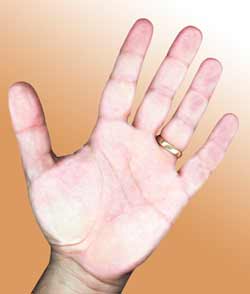You know what Cefaly is, now here’s an overview of using the device, what it feels like, and my early experience with it.
Cefaly has three programs: abortive (programme 1), preventive (programme 2), and relaxation (programme 3). Each program slowly increases in intensity for the first 12 minutes, the levels off and remains at that strength for the remainder of the 20-minute session. You can push the button at any point to stop the intensity from increasing any further. However, according to the manual, “The effectiveness of the treatment depends on the power used. It is consequently advisable to work with the maximum power possible.”
With this in mind, and because I had a migraine coming on, I started with the abortive program (programme 1). Both the lead researcher and the manual say the sensation isn’t painful, so I was surprised by just how intense it is. I agree that pain isn’t the best description (especially for someone used to migraine pain), but the sensation is far from comfortable. Initially, it feels like a mild buzzing vibration with a sharpness to it that’s not quite pins-and-needles. As the program intensifies, so does the vibration and a feeling of pressure develops, like someone is pushing hard against my head with the heel of their hand. Then a sort of clenching sensation begins, almost as if the muscles were tightening. Again, none of these sensations are exactly painful (unless I already have allodynia), but I am always greatly relieved when the program is over. Anyone with significant allodynia will probably find this device unbearable to use.
The first time I used the Cefaly, I had to stop before reaching maximum intensity. It was just too uncomfortable to continue. When the 20 minutes were up, the migraine felt unchanged. I started it up again (one touch of the button in the wind-down period returns the stimulation back to the maximum strength for the session and it remains there for the next 20 minutes), as the manual says,
“The standard 20-minute session is generally too short, except for mild headaches. Usually it is necessary to carry out programme 1 several times, and for at least 40 minutes. Generally, 2 to 6 sessions of 20 minutes each are needed, depending on each individual. This is not always the maximum either, since Cefaly can be used all day long if needed.”
An hour at not quite full strength eased the migraine from a level 5 to a 3. Not only was I able to go to dinner with friends, I was chatty and felt good. The migraine came back three hours later, which has since proven to be a pattern. Multiple times since then, using the device at almost full strength continuously for an hour has reduced the pain by two levels and I’ve been able to function for a while, though the pain is always back after two or three hours.
What’s most interesting about this is that not only is the pain decreased, but so is my primary prodrome symptom of tooth sensitivity. For the last nine months or so, sensitive teeth on the upper left side of my mouth are a reliable indicator that I have a migraine coming on. Even before I notice increased pain or other symptoms, I feel the sensitivity in my teeth, often testing them with a drink of water. Before I use the Cefaly, my teeth are sensitive; afterward they are not. This makes me think that the migraine process is actually being interrupted, though I don’t know if the science backs me up.
Since the manual says the device is most effective if used at full strength, I kept trying to get there. If the migraine is bad enough and thus my allodynia high, the sensation is unbearable. When I have gotten it up to full strength, the muscles in my eyelids twitch, I feel spasms in the muscles around my eyes, and I cannot keep my eyes open. As I am a master at not listening to my body, I ignored these sensations by distracting myself with a podcast while the Cefaly was on. I was rewarded with a broken blood vessel in my eye.
Thanks to a phobia for all things eye-related, this was a message I could not ignore. I backed off after that, setting the Cefaly even lower than I did for the first few sessions. And it stopped being as effective. It simmered a migraine down one level on the pain scale, reduced my tooth sensitivity without eliminating it, and gave me an hour of productive time before the pain came back.
My final assessment won’t come for at least a few months, by which time I should know if it is preventing any migraine attacks. In the 10 days I’ve used it, I believe it has already given me multiple hours in which I could run errands, write, make it to appointments, or do chores when I otherwise would have been relegated to the couch. That’s worth $230 and $10 per electrode for this chronic migraineur.

 Telcagepant, a migraine abortive with much success in clinical trials
Telcagepant, a migraine abortive with much success in clinical trials